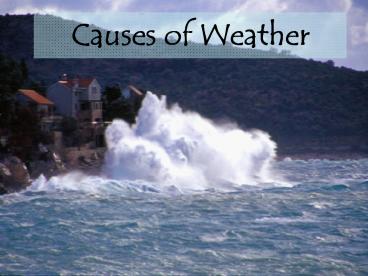Causes of Weather - PowerPoint PPT Presentation
1 / 19
Title:
Causes of Weather
Description:
Causes of Weather Meteorology A meteorologist studies the events and factors of weather A meteorologist knows that there are three ingredients of weather Heat (from ... – PowerPoint PPT presentation
Number of Views:69
Avg rating:3.0/5.0
Title: Causes of Weather
1
Causes of Weather
2
Meteorology
- A meteorologist studies the events and factors of
weather - A meteorologist knows that there are three
ingredients of weather - Heat (from the sun)
- Air
- Moisture
3
Heat, Pressure and Wind Relationship
- We learned that the Earth is heated unevenly
depending on - the location relative to the equator
- type of surface
4
Heat influences air
- Hot air
- Expands
- Becomes less dense
- Rises
- Cold air
- Contracts
- Becomes more dense
- Sinks
5
Air influences pressure
- Hot air
- Cold air
Less Pressure
More Pressure
6
Wind relates to pressure
- Wind always moves from high to low pressure
7
Jet Streams
- Narrow bands of fast, high-altitude westerly
winds - Constant presence due to high temps at equator
and low temps at poles. - Flow up to 185 km / hr
- Jet streams resemble jets of water, which is
where they get their name - Disturbances along jet streams give rise to large
scale weather systems.
8
(No Transcript)
9
Jet Stream
10
Air, heat, and moisture
- Moisture is an ingredient of weather
- We see it as precipitation
- Heat influences what the precipitation looks like
- Snow, rain, hail, etc.
- Air moves moisture
- The density (influenced by heat) of the air
affects how much moisture the air can hold - Warm air, expands, has more space to hold
moisture - Cool air, contracts, has less space to hold
moisture
11
Air Masses
- Air Mass - a large body of air that takes on
characteristics of the area over which it forms - Source region - the region where the air mass
forms - Why are air masses which originate over
- land drier than those over water?
- Duh.air masses are classified according
- to their source regions
12
Source Regions of Air Masses
Abbr. Name Description
(cT) Continental Tropical Warm and dry
(mT) Maritime Tropical Warm and humid
(cP) Continental Polar Cold and dry
(mP) Maritime Polar Cold and humid
(A) Artic Very cold and dry
Air Mass Modification - the exchange of heat or
moisture with the surface over which an air mass
travels
13
(No Transcript)
14
Fronts
- Definition - when 2 air masses with differing
characteristics collide - Colliding air masses can bring dramatic changes
in the weather - Types cold, warm, stationary, and occluded
15
Types of Fronts
- Cold Front -- cold, dense air displaces warm air
- As warm air rises, it cools and condenses
- Clouds, showers and thunderstorms are associated
with cold fronts - Warm Front -- warm air displaces cold air
- Characterized by cloudiness and precipitation
16
- Stationary Front -- 2 air masses meet and neither
one displaces the other - the boundary between air masses stalls
- Rarely has extensive clouds and precipitation
patterns, but the patterns that do occur are
similar to a warm front - Occluded Front -- cold air mass overtakes a warm
front - warm air is lifted, which causes the cold air
mass to collide with the advancing cold front - The warm is squeezed upward between the 2 cold
air masses - Precipitation is common on both sides of the
front
17
Stationary Front
Occluded Front
18
Global Wind Systems
- There are 3 basic wind systems
- Trade Winds - occur at 30o N and S latitude
- At this latitude, NE and SE trade winds occur
- Once the air reaches the equator, it rises again
and moves back toward 30o where it sinks and
starts over again - Prevailing Westerlies - occur between 30o and 60o
N and S latitude - Circular pattern is opposite of trade winds
- They blow from the west to the east
- Polar Easterlies - occur between 60o latitude and
the poles - characterized by cold air
19
The End





























